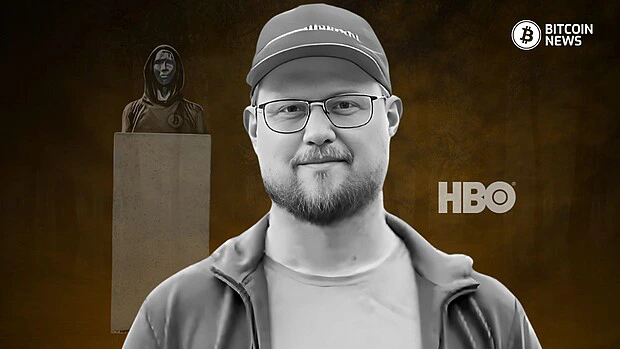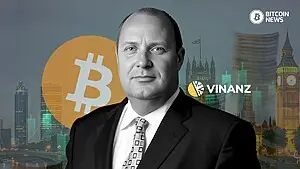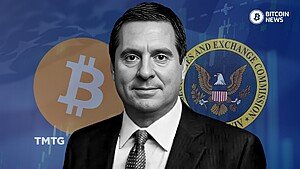A recent HBO documentary, Money Electric: The Bitcoin Mystery, has caused quite a stir in the Bitcoin world by suggesting that Peter Todd, an early Bitcoin developer, is the elusive creator of Bitcoin, Satoshi Nakamoto.
The film’s claim has led to heated debates, conspiracy theories, and a flood of online reactions, with Todd himself stepping forward to deny the allegations.
“Money Electric: The Bitcoin Mystery” delves into one of the internet’s greatest puzzles: the true identity of Satoshi Nakamoto, the pseudonymous figure who introduced Bitcoin to the world in 2008.
Directed by Cullen Hoback, the documentary presents a globe-spanning investigation, interviewing various experts and unearthing cryptic clues to build a case that points to Peter Todd as the mastermind behind Bitcoin.
Toward the film’s dramatic conclusion, when Todd is confronted with the question, he responds with a casual, “Well yeah, I’m Satoshi Nakamoto,” which could be interpreted as a confirmation.
However, those familiar with Todd know that he often jokes about being Satoshi, a point emphasized by many skeptics.
Not long after the documentary aired, Peter Todd took to social media to deny the allegations. He voiced his frustration with HBO and the filmmakers for creating what he called a “dangerous narrative” without consulting him beforehand.
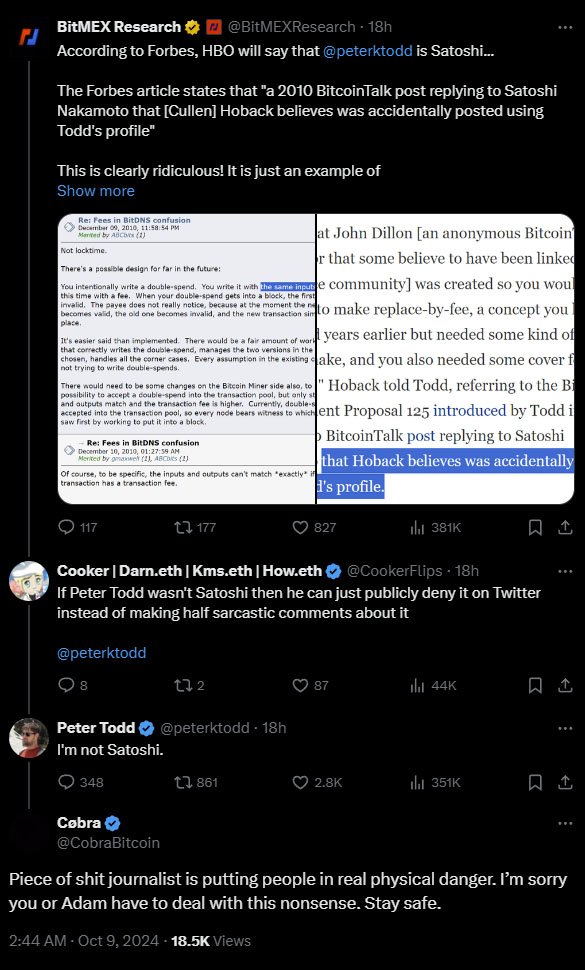
On X, Todd wrote, “I am not Satoshi,” directly refuting the claims made in the film. He also expressed concern for his safety, saying the documentary’s portrayal of him could put his life in danger.
In an interview with CNN, Todd expanded on his objections, criticizing the filmmaker, Cullen Hoback, for making “leaps in logic” and piecing together coincidences to form a speculative narrative.
“Cullen is really grasping for straws here,” Todd said, labeling the film as irresponsible journalism. He added that HBO never gave him the opportunity to screen the film before its release, which heightened his frustration.
The documentary’s release led to a flurry of reactions across the internet, particularly within the Bitcoin community. Pledditor on X called it “one of the least compelling Satoshi Nakamoto identities ever seen.”
On platforms like X, discussions ranged from serious debates to humorous takes on the claim.
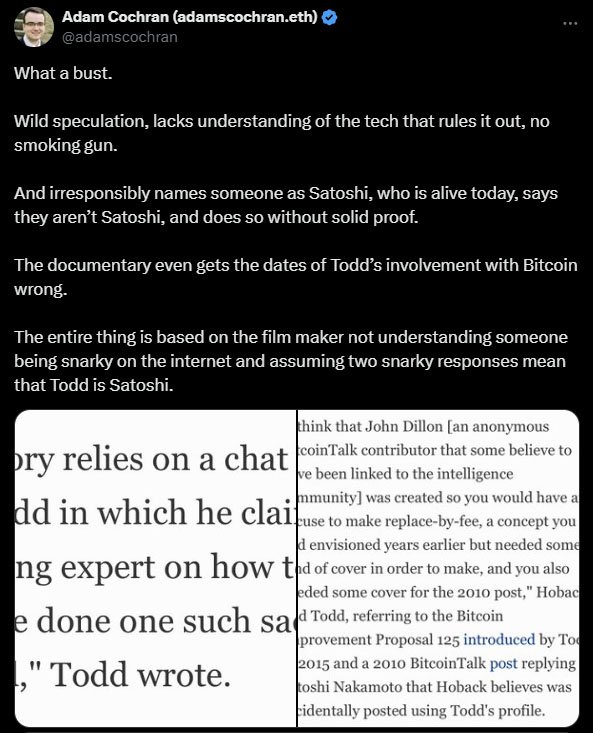
BitMEX Research stated the “evidence” for this claim in the film is “absolutely pathetic”, and called them both wrong and inconsequential at the same time.
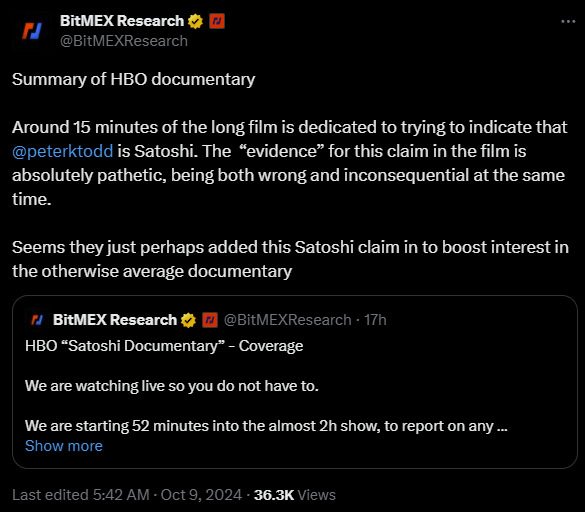
There were also stories shared about people betting large sums of money on who the documentary was going to reveal as Satoshi, with one person reportedly earning $150,000 after the documentary aired.
However, skepticism dominated the conversation. A user by the name @PixOnChain tweeted, “Why would HBO claim Peter Todd is Satoshi? It’s about storytelling… It adds intrigue but doesn’t change reality: Todd isn’t Satoshi. It’s narrative, not fact.”
This sentiment was echoed by many, including prominent Bitcoin figures such as Jameson Lopp, who also expressed doubt about the documentary’s conclusions.

One of the most pointed criticisms came from Beanie, who called the documentary “sloppy journalism.” While Beanie acknowledged that Todd is an important figure in Bitcoin’s development, he questioned whether there was any real evidence linking him to Satoshi Nakamoto.
While Todd’s denial is clear, his history of joking about being Satoshi adds a layer of complexity to the situation.
In a 2019 episode of the What Bitcoin Did podcast, Todd joked, “I am Satoshi, as is everyone else,” a reference to the phrase often used by Bitcoin enthusiasts to emphasize that Bitcoin belongs to everyone.
In the documentary, Hoback leans heavily on a specific chat log message in which Todd refers to himself as “the world’s leading expert on how to sacrifice your Bitcoins.”
According to Hoback, this was Todd hinting at his connection to Satoshi’s legendary bitcoin stash, which remains untouched to this day and is worth billions. Todd, however, dismissed this interpretation, calling it another example of conspiracy thinking.
Part of what makes the Satoshi Nakamoto mystery so captivating is the sheer magnitude of what the person or group represents.
Whoever created Bitcoin not only sparked a financial revolution but also holds around 1.1 million BTC, currently valued at over $65 billion. Yet, Satoshi has remained anonymous for over 15 years, a feat that continues to baffle many.
Experts believe that the elusive creator of Bitcoin possessed extensive knowledge across numerous fields, including cryptography, computer science, distributed and peer-to-peer systems, economics, programming, information security, and mathematics.
They argue that the inventor must have also had a deep understanding of politics, sociology, human psychology, and governance models.
This breadth of expertise has led many to conclude that the entity behind Bitcoin is likely a team of experts, as it seems unlikely for a single individual to master so many diverse areas.
However, this theory has also sparked debate. Some contend that a team could not maintain such a significant secret for this long. As the saying goes, “Three can keep a secret if two of them are dead.”
In the lead-up to Hoback’s final reveal in the film, Peter Todd shared his thoughts on why Satoshi might want to remain hidden. He stated:
“What if the real reason for using the name Satoshi […] was so that people could take Bitcoin seriously? So they could believe it was created by a real cryptographer and not some kid still in school?”
The film appears to use this quote to support its argument. When the Bitcoin White Paper was published, Todd was 23 years old and possibly attending art school.
If so, it suggests that Todd knew Satoshi’s true identity and, in an unintentional slip, revealed that Satoshi is ‘a kid still in school’ rather than a ‘real cryptographer.’
Which, if pieced together, could point out to Todd himself being Satoshi.
Todd’s comment reflects a broader sentiment in the Bitcoin space, where many believe that the mystery surrounding Satoshi’s identity adds to the allure and credibility of Bitcoin.
In the early days of Bitcoin, many cypherpunks and developers embraced the phrase “I am Satoshi” as a way of celebrating Bitcoin’s decentralized nature. This slogan reflects the idea that Bitcoin has no single leader or owner, and anyone who contributes to its growth is, in a sense, Satoshi.
Todd’s occasional use of this phrase likely contributed to the confusion and speculation surrounding his role.
However, for Todd, the attention from the documentary has turned what was once a lighthearted quip into a serious concern. As he told CNN, the claim that he is Satoshi has “real-world consequences,” especially given the massive financial implications of being associated with Bitcoin’s origins.
The Bitcoin community remains divided on the matter.
Some view the documentary as nothing more than a sensationalized attempt to capitalize on the Satoshi mystery. Others are intrigued by the circumstantial evidence, though even those intrigued acknowledge the film’s speculative nature.
Cullen Hoback, the documentary’s director, anticipated the backlash, stating in an interview with Fast Company that he knew naming Todd would spark controversy. He stated:
“People are going to debate it, no matter how strong our case is, and that’s fine. That’s the nature of this space.”
At the end of the day, the identity of Satoshi Nakamoto remains one of the greatest unsolved mysteries of the modern age.
While “Money Electric: The Bitcoin Mystery” shines a spotlight on Peter Todd, the evidence is far from conclusive, and Todd himself has been clear in his denial.
The documentary has certainly stirred conversation and curiosity, but it appears that the world is no closer to discovering who Satoshi truly is.
For now, the mystery continues, with Peter Todd’s name added to the long list of potential candidates, none of whom have been definitively proven to be the legendary creator of Bitcoin.
And as the debates rage on, one thing remains certain: the allure of Satoshi’s anonymity is likely to persist for many more years to come.

